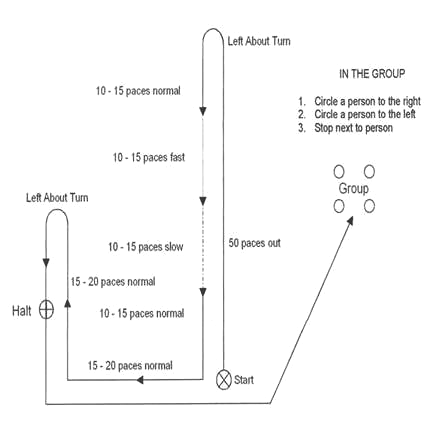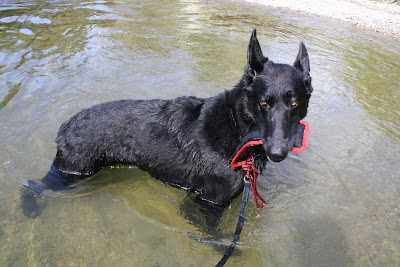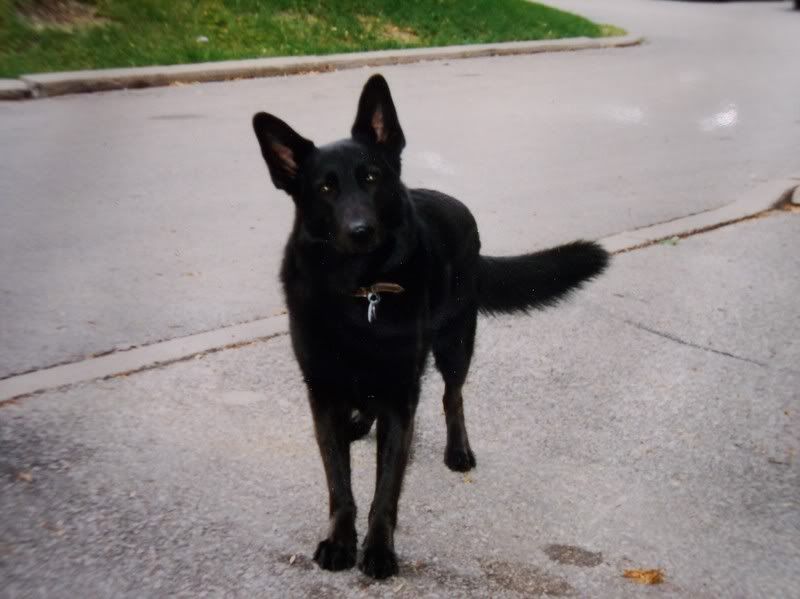
Arlo and me and his High SchH 2 trophy, 84, 77, 75. For full results, click
HereOctober 3rd & 4th 2009, the
Durham Schutzhund Club hosted a fall trial with Judge Nikki Banfield, USA. I had entered Arlo in this trial just a week prior to the event, as although I had planned to enter a fall trial, Arlo had been ill the previous week due to ingesting large quantities of wood.... that's another story. Because of this, I was not sure he was feeling well enough to trial. It turned out he was feeling great, and our practice sessions at the Durham club really impressed me. It seemed that Arlo was finally able to transfer what he has learned to a new location much more easily now. Along with this and some great words of advice from training director Peter Lauder, I was feeling confident going into this trial. Overall, our performance was good. Leading up to the trial I struggled once again to overcome and control my nerves. My nerves got the better of me during the tracking phase, as for the first time that I can remember, the spectators were allowed to come down onto the tracking field. Every other trial I have attended or been entered in, the spectators were required to stay up on the road. They were very close to us, we were the last to track, there were many people there watching, some of whom have world level experience, and well..... this unsettled me. I'm sure my nervousness translated into Arlo's performance, as the conditions were outstanding, plush sod, lots of dew, no detectable wind, the track was visible.... he could have easily put in a 95+ point performance, but instead we ended up with 84. I am not going to complain about that, as he did very well considering my state of being. I had also lost some points due to a misunderstanding of the rules... once again, another story.
Leading up the obedience routine, I was feeling quite unwell... nausea, nervousness, panic! I really don't know why I get into this state of mind, Arlo is a very reliable OB dog, not a high scoring one, but quite predictable. Once we started working, I quickly settled into my "
trial mind", "
in the ring state", "
in the zone".... I don't really know the correct term for this, but it happens almost always when I run agility, which is far more often than I enter a SchH trial. No matter what I am feeling or worried about waiting to go on the field, it all virtually disappears once my dog and I start working together as a team. All I see is my dog, me, and the judge. It's as if no one else is even there, I forget completely all about everyone else. It is a nice state of mind to be in. Arlo and I worked great together, and what a wonderful feeling being out there with my canine partner working as a team. We lost quite a few points on little things... things I admit, I have not worked on at all. I have since begun to work on those "little" things that turned into big point losses once added up, as I do intend to trial with Arlo again. Even though our score was quite low, I did get many comments from the spectators about how nice we looked out there together, including a "nice job in OB" from a 2-time WUSV competitor. But, my favourite comment was from the judge... in her critique, she said that it is obvious that the handler and the dog have an excellent working relationship together. :-)
Arlo did his best work for me, and that is all I can ever ask for.
The protection phase was the one I was most worried about. His bitework has progressively gotten less intense over the years, and this can certainly be attributed to his illness, however I just cannot be certain how much his illness contributes to his performance. However, he had worked great with the helper Jason at our practice sessions before the trial. He was actually more fired up than he has been in a while... a good sign. His protection routine in the trial was very flat, and I did loose a little bit of control a couple of times. I have been told that nervous handlers can have an adverse affect on a dog in trial, but it was difficult for me to tell how much this was an issue for him. We squeaked by with 75 points... a pass, but not enough to move on to a SchH 3 level. One must score minimum 80 points in the protection phase to be eligible to progress. So, we must try again if we want to move on. The following morning Arlo did have a fever of over 40 degrees Celsius, which could certainly have been a contributing factor to his level of intensity on the trial field. The day of the trial I saw no signs of him feeling ill, and I was very diligent to watch for these.
Overall, my experience was good, and I am happy I decided to enter. The judge Nikki Banfield was outstanding, super nice to the competitors, very fair, and very detailed in her critiques, which I found to be very helpful. I felt it was a privilege to have trialed under her. At the end of the trial, she told everyone that the dogs only know what we (the handlers) teach them, so if we are having training issues, then we are to go home and look in the mirror, as it is us and only us who are responsible for those. Then she told everyone to go home and hug their dogs. I think that message really hit home for a lot of people, as it is so true. Our dogs only know what we have taught them...
A big thanks to friends Graham and Josie for the great photos. My camera does not have a good zoom lens yet, but we will have one soon.

Heeling the "J" pattern.

Dumbbell throw over the jump

Retrieve over the frame

Long down

Waiting for our critique

Bark and hold, Jason Peter is the helper

Back transport

Setting up for the "out"

Judge Nikki Banfield after our protection routine critique congratulating Arlo and I on a successful SchH 2 title.

Fun shot after all the awards were handed out.... Josie caught this one of Arlo looking up at his trophy....
 Lafontaine Beach Park... It may not be beautiful in the traditional sense of how we may think of beaches... there are random weeds everywhere, there are different sized rocks scattered all around, the shoreline is irregular, and the sand is course, not fine. But, all I can tell you is that it is beautiful.... I loved it.
Lafontaine Beach Park... It may not be beautiful in the traditional sense of how we may think of beaches... there are random weeds everywhere, there are different sized rocks scattered all around, the shoreline is irregular, and the sand is course, not fine. But, all I can tell you is that it is beautiful.... I loved it. Looking out at the water from higher up the beach... you can see the other side of the shoreline off in the distance, albeit only faintly.
Looking out at the water from higher up the beach... you can see the other side of the shoreline off in the distance, albeit only faintly. A piece of shoreline... here you can see the rocks... these rocks continue out into the water, so I'm not sure how nice this would be for swimming.
A piece of shoreline... here you can see the rocks... these rocks continue out into the water, so I'm not sure how nice this would be for swimming.




 Schutzhund trials are few and far between here in Ontario, so when one is being held, I always try and go out to watch. One can often learn a lot by watching trials, and I find the judges' critiques very helpful. I attended a trial this past weekend as a spectator. I have recently paid very close attention to the handlers in trials. I have found that there is a wide range of handling styles, but they can basically be broken down into 2 broad categories;
Schutzhund trials are few and far between here in Ontario, so when one is being held, I always try and go out to watch. One can often learn a lot by watching trials, and I find the judges' critiques very helpful. I attended a trial this past weekend as a spectator. I have recently paid very close attention to the handlers in trials. I have found that there is a wide range of handling styles, but they can basically be broken down into 2 broad categories; 


































































